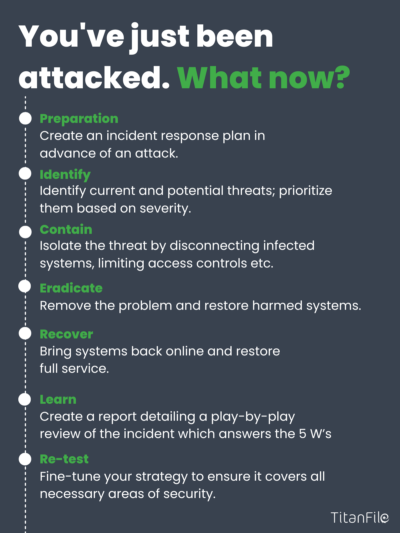Cybersecurity data breaches have been on an upward trend for the past few years. According to Information Security Magazine, data breaches have increased 70% globally in Q3 2022. Nearly, 108.9 million accounts were breached, with the top five affected countries being Russia, France, Indonesia, Spain, and the USA. Since the onset of the global pandemic, many organizations moved to a remote-first work model which resulted in the increased use of storing and sharing data digitally. Unfortunately, online data is a gold mine for hackers and many sophisticated agents have escalated their attempts at data exfiltration on SMBs and Enterprises.
How do Data Breaches Happen?
Cybersecurity threats take on many forms. However, there are tried and true methods that attackers use to target and steal company data. In 2023, these were the most common methods:
1. Ransomeware
Ransomware is a type of malicious software that encrypts a victim’s files or system, making them inaccessible, and demands a ransom payment in exchange for the decryption key. Failure to pay the ransom often results in permanent loss of access to the encrypted data.
2. Phishing
Phishing schemes are fraudulent attempts to obtain sensitive information, such as login credentials or financial details, by impersonating a trustworthy entity in an electronic communication. These schemes often use deceptive tactics, such as fake emails or websites, to trick individuals into revealing their personal information.
3. Malware
Malware is a type of software designed to harm or disrupt computer systems, networks, or devices. It includes viruses, worms, Trojans, and other malicious programs that can steal data, damage files, and compromise the security of the infected system.
4. Distributed Denial of Service (DDoS)
Distributed Denial of Service (DDoS) is a type of cyber attack that involves overwhelming a targeted server, website, or network with traffic from multiple sources, making it unavailable to its intended users. DDoS attacks are often carried out using a botnet of compromised computers or IoT devices.
Who is Affected by Data Breaches?
Until recently, breaches largely involved small-medium businesses due to their lack of cybersecurity structure and planning. However, cybersecurity threats have evolved to target Enterprises and large non-profit organizations. Most recently, the American Bar Association (ABA) issued a notice to clients regarding a data breach resulting in stolen usernames and passwords. Luckily, ABA’s incident response plan was immediately activated in response to lessen the impact.
How to Mitigate the Effects of a Data Breach
If you think a data breach will never effect you, think again. Data breaches are inevitable. Regardless of your security structure, there’s no telling when you’ll be attacked. For companies and clients that manage confidential documents, it’s important to have a plan in place. Following the March 23rd data breach that affected the American Bar Association, their security team:
- Activated its incident response plan
- Removed the unauthorized third party from their network
- Reviewed network security configurations to address continually evolving cyber threats
- Notify clients of the breach and suggests ways to prevent further loss
These are important steps in lessening the impact of a data breach on client data and learning from the experience to improve cybersecurity structures and practices.
Creating an Incident Response Plan
For the optimal protection of client data, it’s highly recommend that companies create a cybersecurity incident response plan. Incident response plans utilize a set of information security policies and guidelines to identify and prioritize risks, mitigate threats and restore service after a cybersecurity breach. The predetermined set of instructions aims to limit the consequences of malicious cyberattacks on an organization’s information system.
The 7 phases of incident response include:
- Preparation – creating an incident response plan in advance of an attack
- Identity – Identify current and potential threats and prioritize them based on severity
- Containment – Isolate the threat by disconnecting infected systems, limiting access controls
- Eradication – Remove the problem and restore harmed systems
- Recovery – Bring systems back online and restore full service
- Learning – Create a report detailing a play-by-play review of the incident which answers the 5 W’s (Who, What, Where When, Why)
- Re-testing – Fine tune your strategy to ensure it covers all necessary areas of security

Most importantly, transparency with clients is key. If your clients data is affected in a breach, it’s important to notify them of the cause, information involved, current status, and strategy.
Conclusion
Cybersecurity threats can be detrimental to a businesses health and unfortunately, it’s not uncommon to become victim to a breach. It’s important for the safety and well-being of your company and clients, that deploy cybersecurity methods to prevent attacks, and in the off-chance, mitigate them. Creating and following an incident response plan, removing unauthorized users from the system, and reviewing cybersecurity best practices to tweak and perfect them.
If you liked this article, please feel free to share it with your network!
